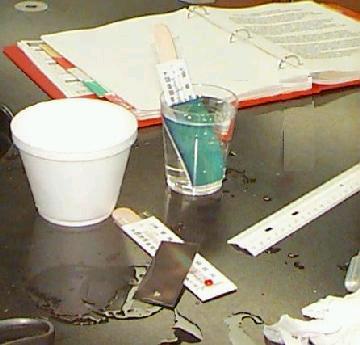
The thermal sensing sheet is a kind of thermometer, but how do we read it? What is the temperature when the sheet is green? Find out, by doing the activity "How warm is green? Calibrate the liquid crystals" (Liquid Crystals #3) in the manual.
The calibration can be done with a little piece 1/4" wide cut from one
edge. Please note that you will want some big pieces later --
so leave most of the squares intact.

 Enter your calibration table into your journals, as well as your answers to the
questions posed in the activity.
Please note the recommendations on taking care of the
thermal sensing sheet.
Enter your calibration table into your journals, as well as your answers to the
questions posed in the activity.
Please note the recommendations on taking care of the
thermal sensing sheet.
The liquid crystal temperature sensing sheet uses organic
materials that are slightly sensitive to air, water, heat, and
age -- so the temperature scale can drift a bit with time.
You may also have noticed that the color depends a bit on
who is looking, and from what angle.
Color blind people will see the colors in still a different
way. The calibration
is specific to your sample, and to the way you calibrated
it. There is no right answer here, except that once you
have calibrated the liquid crystal your way, you should get
consistent results.
Using the liquid crystal sheet to measure the temperature is the hard way to do it; but it is a very good way to show how temperature varies from place to place. We can tell at a glance what would take many measurements with a single thermometer. The important thing you have learned from the calibration is how sensitive it is: whether "green" differs from "brown" by one degree, ten degrees, or one hundred degrees.
Check the box when you are done:
Next activity: What we can learn about temperature and heat using "liquid crystal" thermal sensing sheet